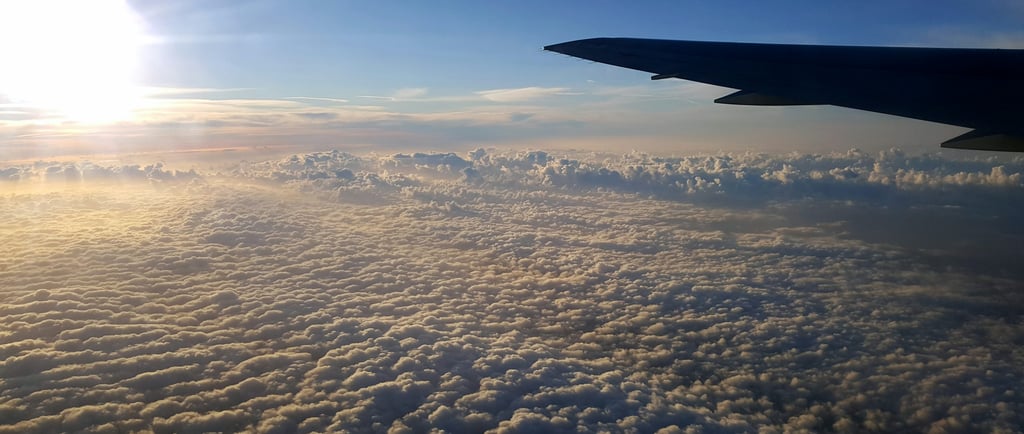Why Do Planes Fly at High Altitudes?
Why so high? The reason planes cruise at 35,000 feet
4/17/20253 min read


Why Do Planes Fly So High?
If you've ever looked at a flight tracker and noticed your plane cruising at 35,000 feet, you might’ve wondered: why so high? Wouldn’t it be easier to fly lower?
Here’s the answer — and it’s all about efficiency, safety, and performance.
1. Less Air = Less Drag
At higher altitudes, the air is thinner. That means there's less resistance (drag) slowing the aircraft down. With less drag, the engines don’t have to work as hard — which means less fuel burned for the same speed.
2. Fuel Efficiency Sweet Spot
Jet engines actually perform better at high altitude. The cooler air helps the engines operate more efficiently, and because there's less drag, aircraft can cruise faster and farther while saving fuel.
3. Avoiding Weather and Turbulence
The higher you go, the more stable the atmosphere tends to be. Most weather systems — like storms and turbulence — happen in the lower atmosphere (the troposphere). Cruising above it makes for a smoother, safer ride.
4. Traffic and Airspace Management
There’s a whole world of aircraft out there. Commercial jets cruising at high altitudes stay well above smaller planes, helicopters, and other traffic closer to the ground. It helps keep air traffic organized and safe.
Why Can't Planes Fly Even Higher?
While it might seem like flying higher would always be better, there’s a hard physical limit — and it’s not about comfort or airspace. It’s about aerodynamics and engine performance.
At very high altitudes, the air becomes extremely thin. And that changes two critical things:
1. Engines lose thrust
Jet engines need air to burn fuel. The thinner the air, the harder it is for engines to produce power. At extreme altitudes, they simply can’t generate enough thrust to keep the plane cruising.
2. Lift drops, stall speed rises
The wings also need air to generate lift. With less air density, the plane has to fly faster to maintain enough lift. But here's where it gets tricky…
3. The Coffin Corner
As you climb higher, your maximum operating speed (Mach limit) gets lower, because going too fast in thin air risks shockwaves and control issues (compressibility effects).
At the same time, your stall speed — the minimum speed needed to keep flying — gets higher, because there's less lift available. Eventually, these two speeds get dangerously close. When there's only a narrow margin between stalling and overspeeding, you enter what's known as the: Coffin Corner
A zone at high altitude where flying becomes extremely unstable — the aircraft has very little room to maneuver, and even a small change in speed or angle could cause a stall or Mach buffet. For most commercial jets, this happens above ~41,000 feet. That’s why aircraft cruise well below that limit — to stay in a safe, stable performance envelope.
Want to fly higher? You’ll need a different kind of aircraft — think military jets or U-2 spy planes, built for thin air and extreme conditions.
Why Do Planes Fly at Certain Altitudes?
How Wind, Fuel Burn, and Time All Interact
Flying isn’t just about getting from point A to B — it’s about doing it efficiently, safely, and on time. That’s why pilots and flight planners are obsessed with choosing the optimal cruising altitude.
Let’s break down how altitude affects wind, fuel, and travel time:
1. Higher Altitude = Lower Air Density = Less Drag
As you climb, the air becomes thinner. This means there’s less aerodynamic drag, so the aircraft can maintain cruise speed with less engine thrust. That’s why fuel burn is lower at higher altitudes — the engines are working more efficiently.
More altitude = better fuel economy.
2. Winds Aloft Can Make or Break Your Plan
But here’s the twist: at high altitudes, you’re flying in the jet stream layer, where winds can be extremely strong, especially between FL300 and FL390.
If you have a tailwind (wind from behind), you’ll fly faster over the ground → shorter flight time and less fuel used.
While If you have a headwind, the opposite happens → you burn more fuel and take longer to get there.
That’s why flights in opposite directions on the same route often fly at different altitudes to catch the best winds.
3. Sometimes Lower is Better (Yes, Really)
If the jet stream is hammering your route with strong headwinds, it might make sense to fly lower, even if that means burning a bit more fuel due to thicker air. Why?
Because avoiding a 100-knot headwind might save you more time and fuel overall than cruising efficiently into a wall of wind.
4. It’s a Balancing Act
Pilots and dispatchers consider:
Aircraft weight (heavier = lower optimal altitude), wind forecasts, fuel prices, traffic and airspace restrictions, time constraints (e.g., slot times, connections),...
The result? A constantly changing plan that finds the sweet spot between saving fuel and saving time. Higher isn’t always better. It depends on winds, weight, and goals: Are we saving fuel, saving time, or avoiding weather?
Created by a commercial pilot to share real-world aviation knowledge.
Join the newsletter to stay updated with weekly insights, articles, and exclusive book content.
contact@transitionaltitude.com
© 2025 Transition Altitude. All rights reserved.